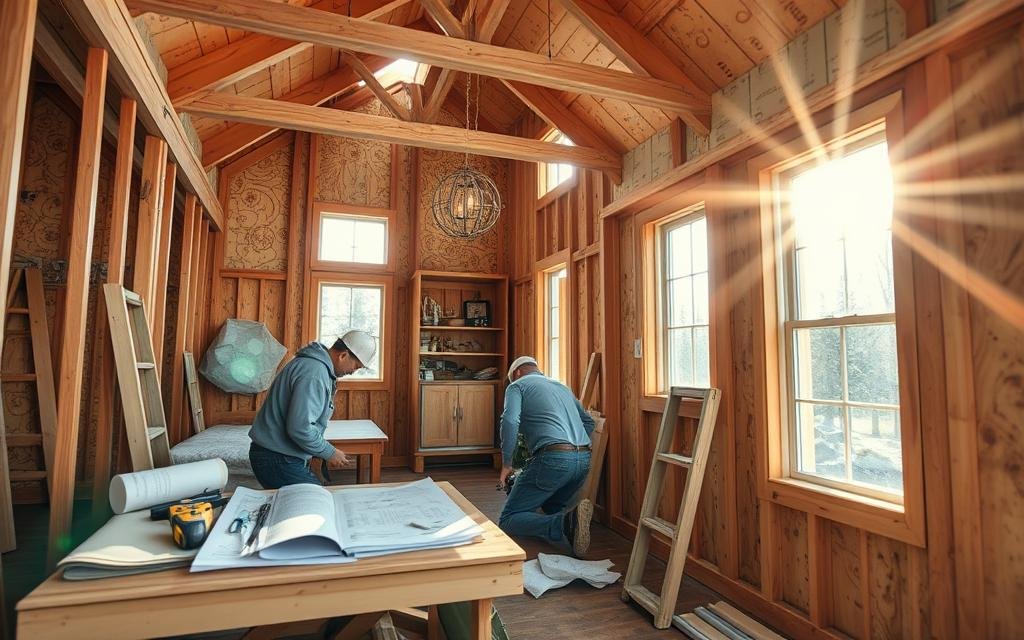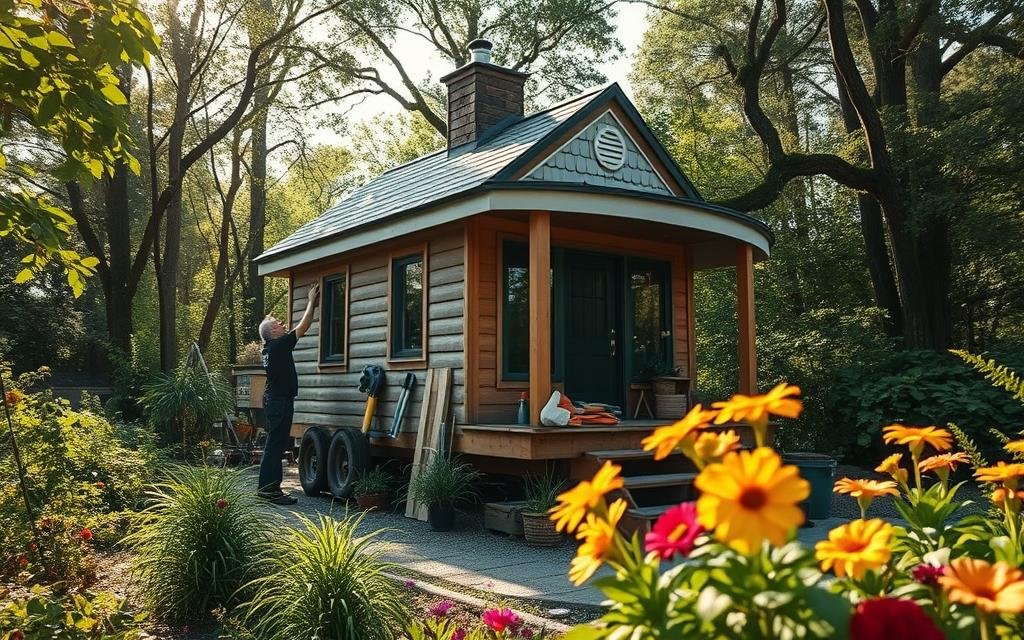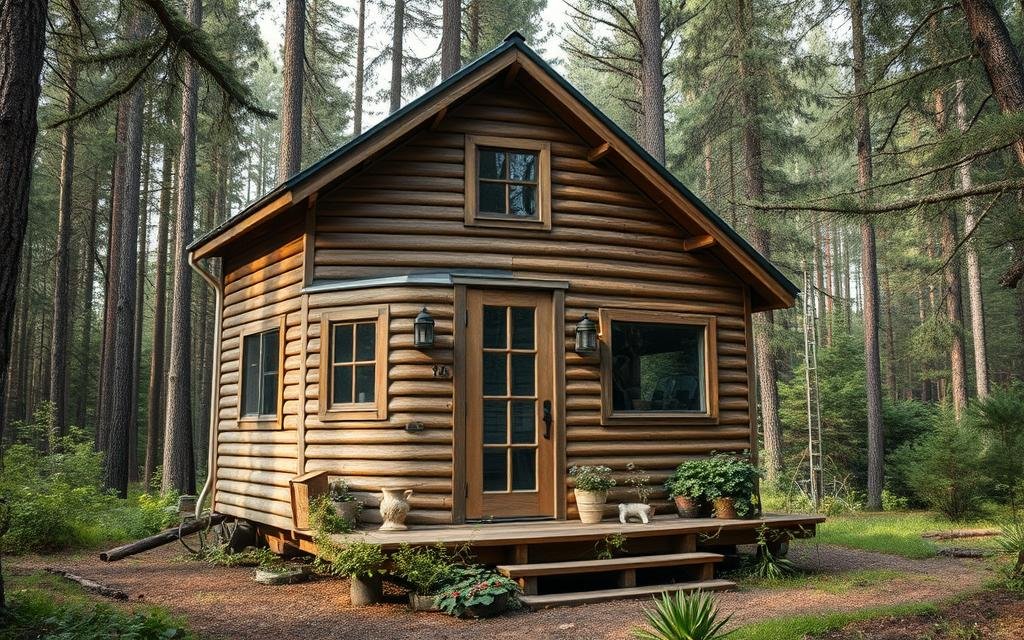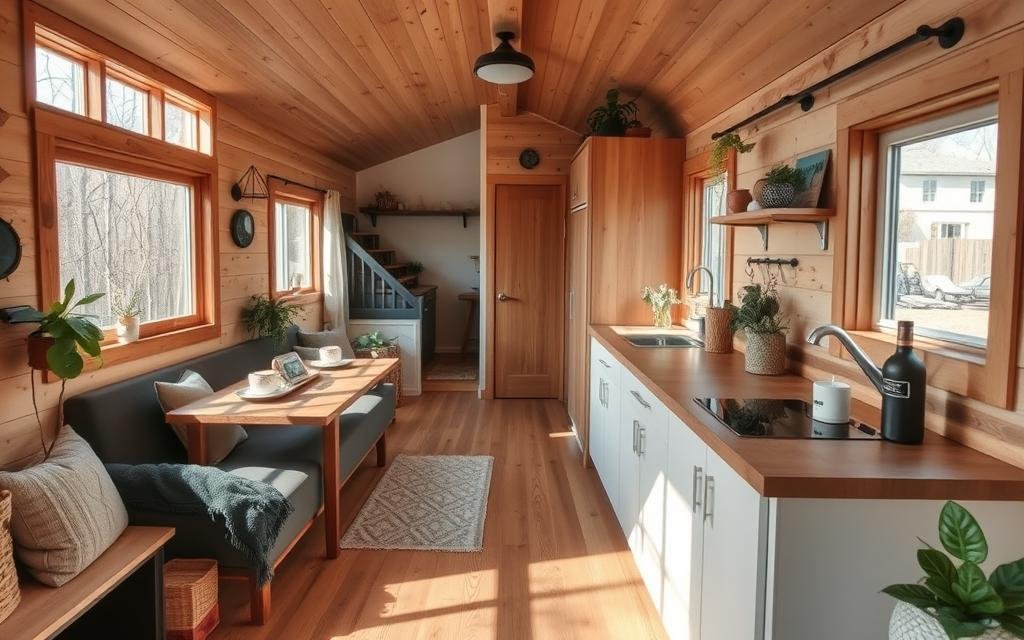Thinking about getting a tiny house? You might wonder how long they last and what makes them durable. Tiny houses can last from 10 to 30 years, based on the materials and how well they were built1. It’s important to think about durability when you decide to downsize.
Knowing what affects a tiny house’s lifespan is key. On average, they can last 20-30 years. But, this can change based on the materials and where you live1. The lifespan of a tiny house depends on many things, including how well you take care of it.
Key Takeaways
- Tiny houses can last for many years if properly maintained, with an average lifespan of 20-30 years1.
- The durability of tiny houses depends on factors such as materials, climate, and maintenance.
- Regular maintenance, such as cleaning exhaust fans every 6 months to 1 year2, can help extend the lifespan of tiny houses.
- Tiny houses are required to have at least one emergency exit point in addition to the main entry and exit point3.
- The cost of a custom-built tiny house ranges from $30,000 to $80,000, influenced heavily by materials and extra features included1.
- Tiny houses typically have a 45% smaller carbon footprint compared to average-sized homes, contributing to sustainable living initiatives1.
The Average Lifespan of Tiny Houses
When we talk about tiny house longevity, it’s key to know they last about 20-30 years, just like regular homes4. But, tiny houses need more maintenance of tiny houses because they’re smaller and built differently5.
Things like the weather, materials, and tiny house care affect how long a tiny house lasts4. If you take care of it, a tiny house can last a long time. But, it might need more repairs and parts replaced often5.
For a tiny house to last long, look at the materials and how it was built4. Using strong materials like solid wood, metal, or durable composites helps a lot5.
Traditional Home vs Tiny House Longevity
Traditional houses in Germany can last 80 to 100 years4. Tiny houses can also last 50 years or more if you take good care of them4.
Factors Influencing Lifespan Expectations
Choosing the right materials and building method is crucial for a long-lasting tiny house4. Regular checks on the roof, facade, and windows are also important5.
Statistical Data on Tiny House Durability
Statistical data shows a well-built tiny house can last 50 years or more with proper tiny house care4. On average, tiny homes last 30 to 50 years with regular maintenance of tiny houses5.
Common Building Materials and Their Durability
Choosing the right materials is key in tiny house construction. You can pick from wood, metal, and plastic, each with its own upkeep needs6. The climate and how well you care for them can affect how long they last7.
Using top-notch materials can make your tiny house last longer, by 10 to 15 years7. Good ventilation is also important. It helps keep humidity down and stops mold from growing, which can harm your tiny house7.
Here’s what you need to know about common materials:
- Wood: can rot and get damaged by insects if not looked after
- Metal: lasts longer, but needs more cleaning and upkeep
- Plastic: strong, but might crack or fade over time
By picking the right materials and techniques, you can build a durable tiny house6.

It’s important to weigh the good and bad of each material and method. This will help you make a smart choice for your tiny house7.
| Material | Durability | Maintenance Requirements |
|---|---|---|
| Wood | Prone to rot and insect damage | Regular maintenance and inspection |
| Metal | More durable | More frequent cleaning and maintenance |
| Plastic | Durable, but prone to cracking and fading | Regular inspection and replacement |
Impact of Climate and Weather on Tiny House Longevity
Climate and weather greatly affect tiny house longevity. Extreme temperatures, humidity, and moisture can damage materials and structures. For example, hot climates can make materials expand and contract, causing cracks8. Cold weather can make materials brittle and prone to cracking9.
Good insulation is key to protect the interior from moisture damage. This is a common cause of tiny house structural issues8. Using quality insulation like closed-cell foam or wool helps with energy efficiency and longevity8. Regular upkeep is important to prevent minor problems, showing the need for consistent maintenance in tiny houses8.
Some important things to consider for tiny house care in different climates include:
- Proper ventilation to prevent moisture buildup
- High-quality, weather-resistant insulation and roofing materials
- Regular inspections to identify and address potential issues
By considering these factors, you can ensure your tiny house lasts longer and keeps its value. Regular maintenance is crucial to extend the life of your tiny house. It should be a top priority for owners9.
The key to a long-lasting tiny house is being aware of climate and weather impacts. Taking proactive steps can help. This way, your tiny house can remain safe, comfortable, and sustainable for years. Proper maintenance is essential for tiny house longevity8.
Foundation Types and Their Effect on Durability
The foundation of a tiny house greatly affects its durability. A good foundation provides a solid base and protects the house from damage. On the other hand, a bad foundation can cause serious problems like structural damage and safety issues10.
The foundation type depends on the house’s size and weight, the climate, and the soil. It also depends on how mobile you want the house to be.
Common foundations for tiny houses include slab-on-grade, crawlspace, and pier foundations. Each has its own pros and cons. The right choice depends on the homeowner’s needs and goals. For example, a slab-on-grade foundation is cheap and easy to install11. But it might not work well in areas with high water tables or poor soil.
The foundation is a key part of a tiny house, made with high-quality materials like concrete and steel12. Using eco-friendly materials can also help the environment.

In conclusion, choosing the right foundation and materials is crucial for a tiny house. This ensures the house is durable and stable. Homeowners can then enjoy a safe and comfortable living space for many years.
Critical Components That Determine How Long Tiny Houses Last
Several key components affect a tiny house’s lifespan. These include the structure, roof, walls, and plumbing. The quality of these parts greatly influences the tiny house construction quality and how long it lasts. Data shows that well-made tiny houses can last as long as regular houses13.
The materials and building techniques used are also vital. For example, using strong screws instead of thin staples can make the structure more solid13. Also, using eco-friendly materials can help the environment14.
Keeping a tiny house in good shape is crucial. This means checking insulation, water tanks, and pipes every year13. It’s also important to inspect roofs after bad weather13. By focusing on these areas and regular maintenance, tiny house owners can enjoy a long-lasting, cozy home.

- Regular plumbing checks
- Annual roof inspections
- Using top-notch tiny house materials
- Choosing effective tiny house building techniques
By following these tips, tiny house owners can keep their homes sturdy and comfortable for many years. This highlights the role of tiny house construction quality and tiny house materials in a tiny house’s lifespan14.
| Component | Importance | Maintenance Requirement |
|---|---|---|
| Structural Framework | High | Annual Inspections |
| Roofing Systems | High | Bi-Annual Checks |
| Wall Construction | Medium | Quarterly Inspections |
| Plumbing Infrastructure | High | Monthly Checks |
Mobile vs Stationary Tiny Houses: Durability Comparison
Choosing between a mobile or stationary tiny house is crucial for longevity. Mobile houses face damage risks from moving, while stationary ones last longer due to their fixed spot15. Keeping your tiny house in good shape is essential, no matter its type.
Mobile tiny houses need more upkeep because of the stress from moving. Stationary houses, being stable, require less care15. Data shows stationary houses last longer, with less damage from moving compared to mobile ones15.
Here are some key differences between mobile and stationary tiny houses:
- Mobile tiny houses are designed to be moved and can be built on trailers for transportation16.
- Stationary tiny houses can use materials like concrete, brick, and big glass windows15.
- Mobile tiny houses are at higher risk of theft and need special tie-downs in windy areas15.
The choice between a mobile and stationary tiny house depends on your needs and wants. Think about longevity, upkeep, and care to choose the right one for you16.

It’s important to consider the pros and cons of each option. Think about your budget, lifestyle, and what you prefer when deciding15.
Essential Maintenance Practices for Longevity
Regular maintenance is key to keeping a tiny house in good shape. This includes tasks done monthly, seasonally, and yearly17. Creating a routine maintenance schedule is vital. It helps spot problems early, saving you from expensive fixes and ensuring your tiny house stays in top condition.
Monthly, you should check the roof, walls, and foundation for damage or wear18. Seasonal tasks like cleaning the siding and roof prepare your home for harsh weather. Also, getting a professional to inspect your tiny house regularly is a smart move. They can find issues and suggest fixes, which is important for keeping your tiny house in good shape17.
Monthly Maintenance Checklist
- Inspect the roof for signs of damage or wear
- Check the walls and foundation for any cracks or gaps
- Inspect the plumbing and electrical systems for any issues
By sticking to a regular maintenance plan, you can make your tiny house last longer. It will stay safe and cozy. Taking good care of your tiny house prevents big problems and saves you money on repairs. This way, you help your tiny house last longer18.

Signs of Wear and When to Address Them
As a tiny house owner, knowing the signs of wear is key to keeping your home in top shape. Regular checks can spot problems early, which is important for tiny house longevity and value. Look out for cracks, damage, and material wear, caused by weather, moving, or bad construction19.
To keep your tiny house in good condition, act fast on any issues. Clean regularly, check insulation, pipes, and tanks, and fix small problems quickly19. Also, using top-notch materials and working with skilled builders can help your tiny house last longer19.
Here are some important things to look for during your checks:
- Cracks in the walls or foundation
- Damage to the roof or siding
- Deterioration of materials, such as rot or mold
- Signs of pest or rodent infestation
By tackling these problems early, you can keep your tiny house safe, cozy, and in great shape for years. This is crucial for tiny house longevity and maintenance of tiny houses20.
Regular checks and upkeep are essential for your tiny house’s long life and to avoid expensive fixes later. By focusing on tiny house care and catching issues early, you can enjoy your tiny home for many years19.
| Inspection Item | Frequency |
|---|---|
| Roof and siding | Every 6 months |
| Insulation systems | Every 6 months |
| Piping and water tanks | Every 6 months |
Cost Considerations for Long-Term Durability
Building a tiny house can be pricey at first, but it might save you money in the long run21. The cost for materials alone can be between $10,000 and $35,000. Labor can add another $20,000 to the bill22. It’s important to think about the ongoing costs, like repairs and insurance.
The materials you choose can greatly affect your home’s upkeep and cost22. While high-quality materials might cost more upfront, they can save you money later. The way your tiny house is built also matters. Using eco-friendly materials and energy-saving systems can cut down on expenses and environmental impact23.
Here’s a look at some costs you might face as a tiny house owner:
| Cost Category | Estimated Cost |
|---|---|
| Initial Investment | $20,000 to $60,00023 |
| Monthly Parking Costs | $300 to $60023 |
| Annual Insurance | $2,31123 |
By looking at these costs and choosing the right materials and techniques, you can get a durable and affordable home. It will meet your needs and stay within your budget.
Professional Builder vs DIY: Impact on Lifespan
Choosing between a professional builder and DIY for your tiny house matters a lot. The tiny house construction quality is key to its lifespan. Custom-built ADUs usually take less than a year to finish, thanks to quality materials24.
A pro builder uses better tiny house building techniques and materials. This makes your tiny house last longer. DIY, while cost-effective, can lead to mistakes that harm the tiny house materials and quality25.
Interested in DIY’ing your own tiny house deck? Please check out DIY New Deck for a Tiny House: Simple Guide.
When deciding, think about these points:
- Building time: Custom ADUs need more planning and permits, taking longer24.
- Material quality: Better materials mean a more durable tiny house26.
- Maintenance costs: Keeping up with maintenance saves money on repairs and energy bills26.
In summary, your tiny house’s lifespan depends on whether you hire a pro or do it yourself. By focusing on tiny house construction quality, tiny house materials, and tiny house building techniques, you can choose wisely25.
Extending Your Tiny House’s Lifespan Through Upgrades
Upgrading your tiny house can make it last longer and increase its value. By choosing energy-efficient appliances and lights, you can save on energy and bills27. Also, using durable materials and better construction methods can make your house last longer.
Some upgrades can also make maintenance of tiny houses easier. For instance, a good gutter system can prevent water damage, saving you up to $2,000 per problem27. Cleaning your roof regularly can also make it last 25% longer28.
To keep your tiny house in top shape, do regular checks and fixes. This can stop big problems and save you money on repairs. By keeping up with maintenance and upgrades, you can enjoy a cozy home for many years29.
Other upgrades to think about include:
* Metal roofing can make your roof last up to 50 years27
* Using native plants in your garden can save up to 50% on water27
* Sustainable gardening can reduce stormwater runoff by 30%27
Conclusion
The lifespan of tiny houses can vary, but with care, they can last a long time30. A well-built tiny house can last 50-70 years or more, just like regular homes30. But, a poorly made tiny house might show problems in just a few years30.
To make your tiny house last longer, regular maintenance is key31. Fix any wear and tear quickly and think about upgrades for better energy use and safety31. Tiny houses use less material, which is good for the environment31. They also cost less to maintain and use, saving you money each month31.
By following these tips, you can enjoy your tiny home for many years31. It’s a compact, sustainable way to live.
To find out how comfortable a tiny house can be, please check out Making Your New Tiny House Comfortable.



